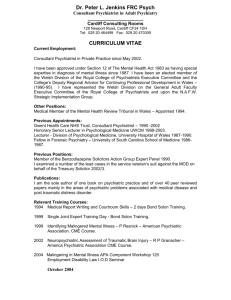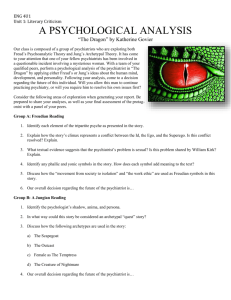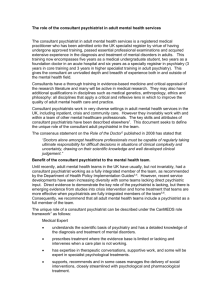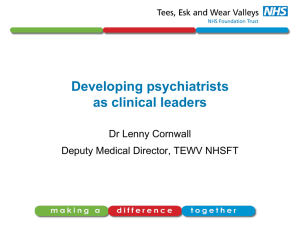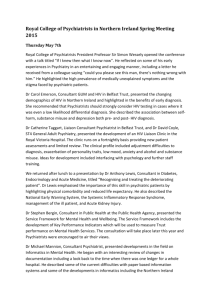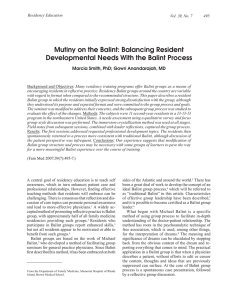Old Ways of Working Dr James Johnston Medical Psychotherapy
advertisement
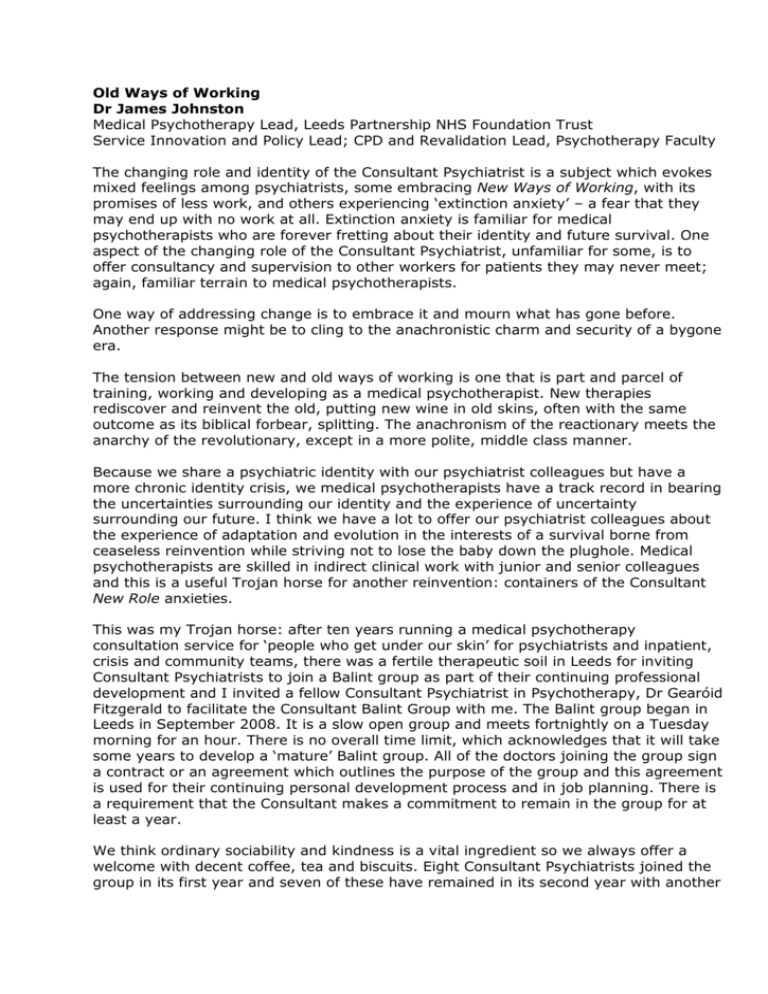
Old Ways of Working Dr James Johnston Medical Psychotherapy Lead, Leeds Partnership NHS Foundation Trust Service Innovation and Policy Lead; CPD and Revalidation Lead, Psychotherapy Faculty The changing role and identity of the Consultant Psychiatrist is a subject which evokes mixed feelings among psychiatrists, some embracing New Ways of Working, with its promises of less work, and others experiencing ‘extinction anxiety’ – a fear that they may end up with no work at all. Extinction anxiety is familiar for medical psychotherapists who are forever fretting about their identity and future survival. One aspect of the changing role of the Consultant Psychiatrist, unfamiliar for some, is to offer consultancy and supervision to other workers for patients they may never meet; again, familiar terrain to medical psychotherapists. One way of addressing change is to embrace it and mourn what has gone before. Another response might be to cling to the anachronistic charm and security of a bygone era. The tension between new and old ways of working is one that is part and parcel of training, working and developing as a medical psychotherapist. New therapies rediscover and reinvent the old, putting new wine in old skins, often with the same outcome as its biblical forbear, splitting. The anachronism of the reactionary meets the anarchy of the revolutionary, except in a more polite, middle class manner. Because we share a psychiatric identity with our psychiatrist colleagues but have a more chronic identity crisis, we medical psychotherapists have a track record in bearing the uncertainties surrounding our identity and the experience of uncertainty surrounding our future. I think we have a lot to offer our psychiatrist colleagues about the experience of adaptation and evolution in the interests of a survival borne from ceaseless reinvention while striving not to lose the baby down the plughole. Medical psychotherapists are skilled in indirect clinical work with junior and senior colleagues and this is a useful Trojan horse for another reinvention: containers of the Consultant New Role anxieties. This was my Trojan horse: after ten years running a medical psychotherapy consultation service for ‘people who get under our skin’ for psychiatrists and inpatient, crisis and community teams, there was a fertile therapeutic soil in Leeds for inviting Consultant Psychiatrists to join a Balint group as part of their continuing professional development and I invited a fellow Consultant Psychiatrist in Psychotherapy, Dr Gearóid Fitzgerald to facilitate the Consultant Balint Group with me. The Balint group began in Leeds in September 2008. It is a slow open group and meets fortnightly on a Tuesday morning for an hour. There is no overall time limit, which acknowledges that it will take some years to develop a ‘mature’ Balint group. All of the doctors joining the group sign a contract or an agreement which outlines the purpose of the group and this agreement is used for their continuing personal development process and in job planning. There is a requirement that the Consultant makes a commitment to remain in the group for at least a year. We think ordinary sociability and kindness is a vital ingredient so we always offer a welcome with decent coffee, tea and biscuits. Eight Consultant Psychiatrists joined the group in its first year and seven of these have remained in its second year with another Consultant joining. The Consultants are from a range of specialties, six General Adult Psychiatrists (one in R&R), one in Learning Disability and one in Liaison Psychiatry. The process in every group is to ask whether any of the doctors feel moved to discuss someone: there is no pre-planned rota. The idea is to ascertain who amongst the doctors has the most pressing need to present and while sometimes two doctors have asked, there is usually a rapid agreement without bloodshed. In the early groups the ceiling and carpet suddenly became very interesting as we waited until a doctor volunteered but this hasn’t been the case in the past year as the group has developed its rhythm and safety. The presenting doctor talks about a patient without notes and voices the emotional dilemma in the relationship with either the patient or their carers, colleagues or a combination. There is an emphasis on the doctor’s emotional experience, which involves some form of conflict. There would then be three or four questions of fact of the doctor and then the presenting doctor would not say any more, remaining silent and allowing the group to speculate about the doctor’s dilemma and their impressions of it. While discussing the presenting case the other doctors do not engage directly with the presenting doctor but reflect on the dilemma without offering advice or guidance on management. The doctor who has presented rejoins the discussion around 10 minutes from the end of the group and is offered an opportunity to say what had struck them in the discussion that they had listened to. The aim of the discussion in the group is not to find solutions for the doctor’s dilemma but to free up the doctor so that the next time they meet the patient they may feel less burdened by the previous difficulties that they have encountered and to allow something different to potentially emerge with the patient. The Consultant Psychiatrists in this group are at different stages in their careers, some at the very start, some in the middle, some toward the end. Some of the more recently appointed psychiatrists have also described the benefit of listening to more senior colleagues and the relief they feel that they can see that their senior colleagues continue to struggle with issues in the relationship with their patients and it’s not simply a matter of inexperience that one has difficult feelings about some of our patients. One of the themes that we have discerned in the group is to do with the hidden work Consultant Psychiatrists hold or bear on behalf of their Teams. The group offers a space to allow this invisible work with emotionally challenging patients to become visible. The group is beginning to provide a trusted space for what is difficult about difficult patients, the difficult feelings they evoke, to be considered. This traditional Balint method, a tried and tested old way of working seems to be having a contribution to the ‘older’ clinicians which is helping them to develop a new way of working in their development and may help to enhance the therapeutic culture to support the integration of psychodynamic ideas in day to day psychiatry for junior clinicians too. Balint groups for junior doctors in the ‘early developmental curriculum’ are arguably not well placed at the start of the psychiatrist’s journey if they are conceived as originally designed, to foster self reflection about the doctor-patient relationship. I have often thought it’s a lot to ask of junior doctors that they not only learn the principles and practice of the psychiatric approach to patients but are invited to perform psychotherapeutic gymnastics to mentally step aside to reflect on their relationship with those patients. However, I do not see this as the primary aim of core trainee Balint groups; I would see the groups the starting psychiatric trainees join as primarily supportive peer groups where the task of self reflection is secondary to survival and passing the exam. Experience in Leeds of post membership Balint groups with ST4-6 trainees show they can make a more mature use of the self reflective purpose of the group and this capacity to use the group is understandably developed still further as Consultants. The developmental differences in the career stage of each psychiatrist is one factor in their capacity to make emotional use of the group, but another is the difference between the personalities of the doctors in terms of their emotional fluency. I have researched Balint groups comprising both GPs and psychiatrists together and discovered that they use the group in an emotionally different way. This difference seems to be linked to stage in career, professional culture and the depth of disturbance the doctor is exposed to as well as the doctor’s characteristic emotional distance from their patient (that is, their empathic valency to tend be closely identified or counteridentified with the patient’s experience). I would advocate Balint groups for all stages of the therapeutic development for all psychiatrists, in the non-mandatory post membership ‘curriculum’ called CPD of those who choose to seek a later therapeutic experience which is purely for the purpose of enhancing their personal understanding and development to improve their patient care. This is a model of ‘cradle to grave’ Balint groups as it were. Emotional literacy can be developed but it can also be lost, particularly when subject to the cumulative psychic assaults that are quotidian in mental health work. Emotional literacy involves continuing self reflection and this can be eroded by the demands of functioning in a system which calls more for action than for thought. There is an incessant institutional imperative to act to maintain safety and reduce risk and in this context reflection can seem at best a luxury and at worst a form of neglect of the primary task, a kind of peripheral purposeless pondering. The demand to do is subverted by the psychotherapeutic mantra: ‘don’t just do something, sit there!’ A safe and supportive space in which to foster continuing curiosity with our colleagues about our own minds and the minds of our patients can enhance the possibility of ensuring the survival of the self reflective capacity that underpins good psychiatric practice. The patient’s fight with help or flight from help in a mute withdrawal leaving a narcissistically wounded clinician behind (see my ‘Psychic Warrior’ cartoons: tanks very much and keeping mum, 2007) are part of the psychiatric resilience underpinning an old way of working which is not to be easily displaced by New Ways of Working. This is the emotional function of bearing being uncertain, of being the bad object who makes nasty decisions and often what is hardest, of bearing the limits of what is possible for the patient but doing so in an invisible, frequently unacknowledged way. The need to cure but being the bearer of the disillusionment of not curing are tensions for all clinicians but are often passed to the senior doctor to bear on behalf of the team. This function of the Consultant Psychiatrist, to bear anxiety about being disturbed, being dead and being defended on behalf of the teams they work in, will not disappear with reduced case loads. This essential role will not readily be made redundant. In psychoanalytic terms it is the vital function of the containment of fear about risk and retribution that are the poisoned chalice to the daily bread and butter of psychiatric work. Case based discussion groups are likely to be the main vehicle for assessing a Consultant Psychiatrist’s clinical work for revalidation, probably based on the existing personal development planning (PDP) groups. The Consultant Psychiatrist Balint group would not lend itself to the assessment of the doctors’ competence as it is in my view an important and necessarily protected space for revealing, not the doctor’s incompetence, but the limitations inherent in the continuous developmental process of becoming, being and remaining a good doctor. Tanks very much Keeping Mum
